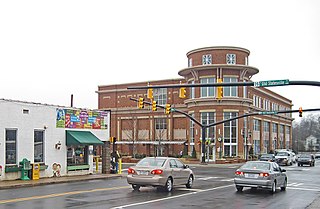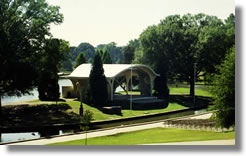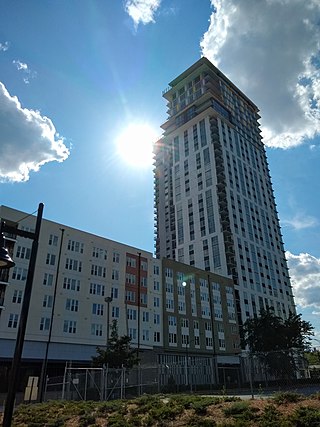
Charlotte is the most populous city in the U.S. state of North Carolina. Located in the Piedmont region, it is the county seat of Mecklenburg County. The population was 874,579 at the 2020 census, making Charlotte the 16th-most populous city in the U.S., the seventh most populous city in the South, and the second most populous city in the Southeast behind Jacksonville, Florida. The city is the cultural, economic, and transportation center of the Charlotte metropolitan area, whose 2020 population of 2,660,329 ranked 22nd in the U.S. Metrolina is part of a sixteen-county market region or combined statistical area with a 2020 census-estimated population of 2,846,550.

Mecklenburg County is a county located in the southwestern region of the state of North Carolina, in the United States. As of the 2020 census, the population was 1,115,482, making it the second-most populous county in North Carolina and the first county in the Carolinas to surpass one million in population. Its county seat is Charlotte, the state's largest city.

Huntersville is a large suburban town in Mecklenburg County, North Carolina, United States. A part of the Charlotte metropolitan area, the population was 61,376 at the 2020 census, making Huntersville the 15th largest municipality in North Carolina. It is located 14 mi (23 km) north of Charlotte.

Rockingham is a city in Richmond County, North Carolina, United States, named after the Marquess of Rockingham. The population was 9,558 at the 2010 census. It is the county seat of Richmond County.

The Tech Interactive is a science and technology center that offers hands-on activities, labs, design challenges and other STEAM education resources. It is located in downtown San Jose, California, adjacent to the Plaza de César Chávez.

The Science Museum of Minnesota is an American museum focused on topics in technology, natural history, physical science, and mathematics education. Founded in 1907 and located in Saint Paul, Minnesota, the 501(c)(3) nonprofit institution has 385 employees and is supported by volunteers.
Central Piedmont Community College is a public community college in Charlotte, North Carolina. With an enrollment of more than 40,000 students annually, Central Piedmont is the second-largest community college in the North Carolina Community College System and the largest in the Charlotte metropolitan area. The college has six campuses and three centers and offers nearly 300 degree, diploma and certificate programs.

Uptown Charlotte, also called Center City, is the central business district of Charlotte, North Carolina. The area is split into four wards by the intersection of Trade and Tryon Streets, and bordered by Interstate 277 and Interstate 77. The area is managed and overseen by the Charlotte Central City Partners, which is one of the three Municipal Service Districts in Charlotte. Uptown Charlotte is the largest business district in Charlotte and the Carolinas.

The Charlotte Trolley was a heritage streetcar that operated in Charlotte in the U.S. state of North Carolina. The line ran along the former Norfolk Southern right of way between Tremont Avenue in the Historic South End in a northerly direction to its terminus at 9th Street Uptown. It ran on tracks mostly shared with the LYNX Blue Line.

The Great Lakes Science Center is a museum and educational facility in downtown Cleveland, Ohio, United States. Many of the exhibits document the features of the natural environment in the Great Lakes region of the United States. The facility includes signature (permanent) and traveling exhibits, meeting space, a cafe, and an IMAX Dome theater.
The Molecularium Project is an informal science education project of Rensselaer Polytechnic Institute. The Project introduces young audiences to the world of atoms and molecules using character driven stories, immersive animation, interactive games and activities, and state of the art molecular visualizations. Rensselaer's three principal scientist and educators behind the project are Linda Schadler, Richard W. Siegel, and Shekhar Garde. The Molecularium Project began as an outreach project of Rensselaer's Nanoscale Science and Engineering Center. To realize the productions, the scientists employed the creative team Nanotoon Entertainment, led by writer and director V. Owen Bush, and writer/producer Kurt Przybilla. The Molecularium Project is funded by Rensselaer, the National Science Foundation, and New York State.
The Mint Museum, also referred to as The Mint Museums, is a cultural institution comprising two museums, located in Charlotte, North Carolina. The Mint Museum Randolph and Mint Museum Uptown, together these two locations have hundreds of collections showcasing art and design from around the globe.

Freedom Park is a 98-acre park in Charlotte, North Carolina. Located at 1900 East Boulevard, between Charlotte's historic Dilworth and Myers Park neighborhoods, the park is centered on a 7-acre lake, and is about 3 miles (4.8 km) from the heart of Charlotte's downtown area.

Levine Center for the Arts on South Tryon Street in Charlotte, North Carolina, includes Bechtler Museum of Modern Art, the Harvey B. Gantt Center for African-American Arts + Culture, the Knight Theater, and the Mint Museum Uptown. It was named for Leon Levine, whose foundation provided financing.

The Charlotte metropolitan area, sometimes referred to as Metrolina, is a metropolitan area of the U.S. states of North and South Carolina, within and surrounding the city of Charlotte. The metropolitan area also includes the cities of Gastonia, Concord, Huntersville, and Rock Hill as well as the large suburban area in the counties surrounding Mecklenburg County, which is at the center of the metro area. Located in the Piedmont, it is the largest metropolitan area in the Carolinas, and the fourth largest in the Southeastern United States. The Charlotte metropolitan area is one of the fastest growing metropolitan areas in the United States.
Discovery Place Nature, formerly Charlotte Nature Museum, is located at 1658 Sterling Road in Charlotte, North Carolina. The Museum features interactive nature exhibits and live animal displays, including a butterfly pavilion, live species, insects, and a variety of native North Carolina animals. The Museum offers many education programs for schools, parents and the public, and features a summer camp program. Daily programming including puppet shows and hands-on activities provide the opportunity for structured learning and informal play.
Spirit Square, also called Spirit Square Center for the Arts, is located in Charlotte, North Carolina. Its McGlohon Theater in the former First Baptist Church on North Tryon Street, named for Loonis McGlohon, is now part of North Carolina Blumenthal Performing Arts Center.

Ally Charlotte Center is a 2-building development in Uptown Charlotte, North Carolina. The office building was officially completed on May 3, 2021, it stands at a height of 378 (115.2). Each floor has an open floor plan and averages approximately 30,000 square feet in size for a total of 742,000 square feet of space which makes it the tenth largest building in Charlotte by leasable space. The site features a 381-room JW Marriott hotel including 34 suites, the first JW Marriott in North Carolina. The site also includes 25,000 square feet of restaurant and retail space, and an 8-story parking garage with 1,400 parking spots.

The Ellis is a high-rise residential building in Uptown Charlotte, North Carolina. Construction was completed on June 23, 2021. It was developed by Lennar. It is between Eight and Ninth Streets on N College St fronting the Lynx Blue Line.














